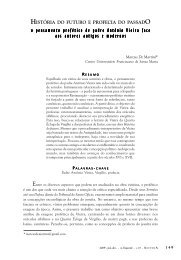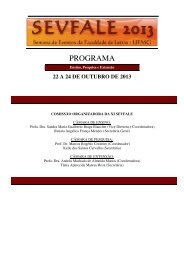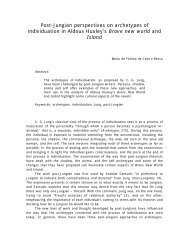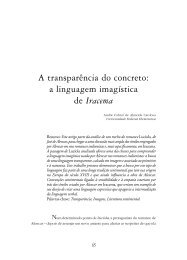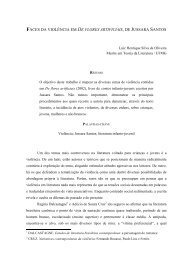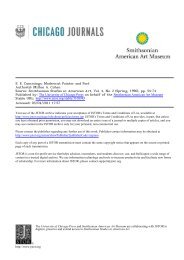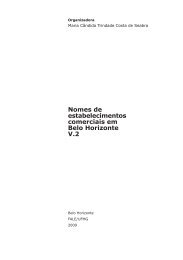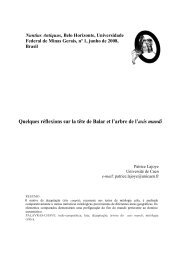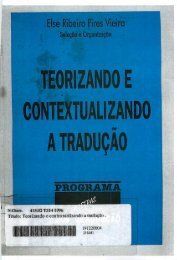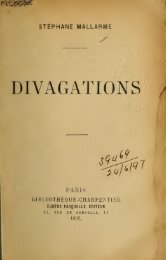Contornos do Indizível: o estilo de Clarice Lispector - Fale - UFMG
Contornos do Indizível: o estilo de Clarice Lispector - Fale - UFMG
Contornos do Indizível: o estilo de Clarice Lispector - Fale - UFMG
You also want an ePaper? Increase the reach of your titles
YUMPU automatically turns print PDFs into web optimized ePapers that Google loves.
Em Tese, Belo Horizonte, v. 10, p. 196-201, <strong>de</strong>z. 2006<br />
mother’s and her daughter’s <strong>de</strong>ath. Sethe’s disjointed voice, full of gaps and ruptures,<br />
reveals how unpleasant it is both to speak about the unspeakable and to remember a<br />
past that cannot be spoken: “Beloved, she my daughter, She mine […] my love was<br />
tough and she back now […] I never saw her own smile […] I won<strong>de</strong>r what they was<br />
<strong>do</strong>ing when they was caught […] before they hanged her and let me be one [...]” (201-<br />
03). Her rememories about that horren<strong>do</strong>us past were so agonizing that they came in<br />
broken and disconnected parts in which the <strong>de</strong>ath of her mother was fused with of her<br />
daughter’s.<br />
In<strong>de</strong>ed, Sethe’s real healing initiates with her reintegration into her community,<br />
at the end of the novel, because being part of a community again means that she was<br />
not alone anymore, as she felt after her mother’s and daughter’s <strong>de</strong>aths. The<br />
community ritual of rescuing her is a symbol of forgiveness. Sethe’s complete healing<br />
seems to occur because of an important process of the reconstruction and the<br />
acceptance of her self-love, as Paul D once affirmed to her: “You your best thing,<br />
Sethe. You are” (273). Sethe has to learn how to love herself, and accept herself as a<br />
person who needs to give and take love, as her mother-in-law, Baby Suggs, had<br />
taught her and the other former slaves at the Clearing: “we flesh; flesh that weeps,<br />
laughs; flesh that dances on bare feet in grass. Love it. Love it hard […] Love your<br />
eyes … your hands … your face … You got to love it, You!” (88).<br />
Therefore, in Beloved, the presence of the past is <strong>de</strong>cisive to the transformation<br />
of the present of most of the characters, especially Sethe’s present. In this novel, as I<br />
have emphasized before, the past returns in the form of Sethe’s <strong>de</strong>ad daughter<br />
Beloved, who comes back from the “other si<strong>de</strong>” (75) eager to join the broken parts of<br />
her history. She claims for her place and for the history to which she thinks she<br />
belongs. She reclaims her place in Sethe’s history and present life as she emphatically<br />
says to her sister Denver: “She (Sethe) is the one I need […] I belong here […] this is<br />
where I am” (76). Therefore, Beloved represents the personal, social, and spiritual<br />
unease that involves the era of slavery, in which thousands of slaves were victims of<br />
those unspeakable times.<br />
As the narrative suggests, Beloved’s presence symbolizes the past that haunts<br />
the present by not being fairly told and analyzed throughout the centuries. It has to be<br />
remembered, re-membered, and re-examined in or<strong>de</strong>r to be accommodated, otherwise<br />
it will continue as fragmented and disconnected rememories that cannot be controlled<br />
or forgotten. Thus, in Morrison’s narrative, African Americans’ collective rememories<br />
are ma<strong>de</strong> alive in Beloved’s broken and disconnected speech. By trying to forget and<br />
bury a painful past still alive, Americans are forced to face the ghosts that will always<br />
come to reclaim their (hi)stories and also to remind American society that there is a<br />
past to be re-examined and restored in or<strong>de</strong>r to bring justice and healing of<br />
unspeakable wounds.<br />
Therefore, Morrison’s narrative that reappropriates, remembers, and re-members<br />
the African American past is an attempt to pass on that chapter of American history. A<br />
past that remains unspeakable, although it urges for discussion and revision, in spite of<br />
the fact that the processes of remembering and re-membering are not painless. As<br />
Amy — a white girl who helped Sethe to <strong>de</strong>liver Denver — says: “more it hurt more<br />
better it is. Can’t nothing heal without pain” (78). Beloved’s voice, presence and<br />
actions show that she returns to bring pain, but at the same time, healing, and, above<br />
all, make people remember what cannot be forgotten. Definitively, as Morrison seems<br />
to state, the slavery history is a story to pass on.<br />
200<br />
Disponível em http://www.letras.ufmg.br/poslit



